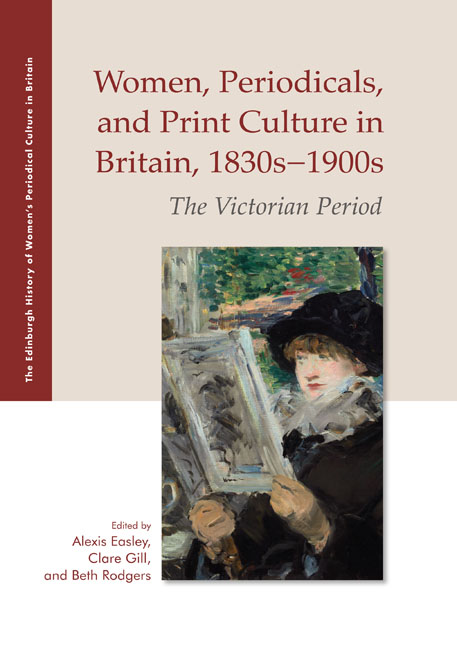Book contents
- Frontmatter
- Contents
- List of Illustrations
- Acknowledgments
- Introduction: Women, Periodicals, and Print Culture in the Victorian Period
- Part I (Re)Imagining Domestic Life
- (Re)Imagining Domestic Life: Introduction
- 1 The Rise and Rise of the Domestic Magazine: Femininity at Home in Popular Periodicals
- 2 Regulating Servants in Victorian Women's Print Media
- 3 Women Editors’ Transnational Networks in the Englishwoman's Domestic Magazine and Myra's Journal
- 4 Women and Family Health in the Mid-Victorian Family Magazine
- 5 Negotiating Female Identity in Nineteenth-Century Ireland
- 6 Women and the Welsh Newspaper Press: The Cambrian News and the Western Mail, 1870–1895
- Part II Constructing Modern Girls and Young Women
- Part III Women and Visual Culture
- Part IV Making Space for Women
- Part V Constructing Women Readers and Writers
- Part VI Intervening in Political Debates
- Notes on Contributors
- Index
- Plate section
2 - Regulating Servants in Victorian Women's Print Media
from Part I - (Re)Imagining Domestic Life
Published online by Cambridge University Press: 25 October 2019
- Frontmatter
- Contents
- List of Illustrations
- Acknowledgments
- Introduction: Women, Periodicals, and Print Culture in the Victorian Period
- Part I (Re)Imagining Domestic Life
- (Re)Imagining Domestic Life: Introduction
- 1 The Rise and Rise of the Domestic Magazine: Femininity at Home in Popular Periodicals
- 2 Regulating Servants in Victorian Women's Print Media
- 3 Women Editors’ Transnational Networks in the Englishwoman's Domestic Magazine and Myra's Journal
- 4 Women and Family Health in the Mid-Victorian Family Magazine
- 5 Negotiating Female Identity in Nineteenth-Century Ireland
- 6 Women and the Welsh Newspaper Press: The Cambrian News and the Western Mail, 1870–1895
- Part II Constructing Modern Girls and Young Women
- Part III Women and Visual Culture
- Part IV Making Space for Women
- Part V Constructing Women Readers and Writers
- Part VI Intervening in Political Debates
- Notes on Contributors
- Index
- Plate section
Summary
THE ACQUISITION, MANAGEMENT, and control of servants was a significant domestic task and expectation for women of secure financial status or aspiring social rank during the Victorian period. As Eric Hobsbawm notes, ‘The widest definition of the middle classes or those who aspired to imitate them was that of keeping domestic servants’ (1999: 134–5). Sally Mitchell adds that ‘domestic service was the largest single category of work for women and girls’; in 1851, ‘13.3 percent of the employed population were in domestic service; in 1881, 15.9 percent’ (1996: 50). Most middle-to upper-class women's periodicals of the mid-Victorian era featured articles about using proper etiquette with servants, demonstrating adequate degrees of personal interest, and monitoring dishonesty or carelessness among all levels of domestics. A burgeoning genre of household manuals assisted the effort from downstairs, instructing servants on everything from scouring floors to washing lace. Margaret Beetham comments on the challenge faced by middle-class women: ‘Underpinning the home beautiful was the work of the domestic servant and a woman's regulation of her home was nowhere more evident than in the success with which she managed this other woman. The servant “problem,” as defined in these papers, was multiple; finding, training, keeping and controlling’ (1996: 106). Obedient, respectful domestics signified class and gentility in the family, and middle-class women's print media supported the status quo with sympathy, advice, and instruction on how to manage unpredictable or bewildering elements of a servant class they viewed as potentially oversexed, radical, or otherwise immoral. However, until the last quarter of the century, servants had no voice in women's print media other than the narrative authority of addressing subordinates.
The 100-page guide titled Common Sense for Housemaids (1853) demonstrates the extreme but probably typical demands placed on servants during the 1840s and 1850s. The first task for any housemaid, according to the author (‘A Lady’), is to clean every room in the house from top to bottom according to minute specifications. The natural reward for the housemaid is that she can then ‘look round with modest triumph, and exclaim, Sublime. A drawing-room in perfect order, how lovely is it!’ (1853: 27).
- Type
- Chapter
- Information
- Women, Periodicals and Print Culture in Britain, 1830s–1900sThe Victorian Period, pp. 32 - 45Publisher: Edinburgh University PressPrint publication year: 2019

